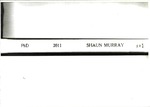Eniatype: Transdisciplinary Practice for Methodologies of Communication
| dc.contributor.supervisor | Ascott, Roy | |
| dc.contributor.author | Murray, Shaun Patrick | |
| dc.contributor.other | Faculty of Arts, Humanities and Business | en_US |
| dc.date.accessioned | 2011-02-10T17:43:31Z | |
| dc.date.available | 2011-02-10T17:43:31Z | |
| dc.date.issued | 2011-01 | |
| dc.identifier | 303741 | en_US |
| dc.identifier.uri | http://hdl.handle.net/10026.1/312 | |
| dc.description | Full version unavailable due to 3rd party copyright restrictions. | |
| dc.description.abstract |
The thesis demonstrates a rethinking of methodologies of communication through ecological design. Human communication and ecological accountability are inextricably linked in architectural design: the current global ecological crisis underscores this fundamental connection. Within architectural practice the communication from architect to participant or environment is not at all straightforward. This is also true of the dyadic relation between context, design and communication in architectural education. Notational systems within architectural education used as a communication tool have made the composition of architecture an activity like the composition of fiction: the activity of communication. So deep is the connection between architecture and communication in our culture that for much of the time we ignore it and behave as if notation were really a transparent window – just as in reading a working drawing in architectural practice we may ignore the intermediacy of notation and imagine that thoughts are reaching us directly from the architect’s mind. The most important criterion of notational systems, whether literally or architectural, is precisely that it should not draw attention to itself, nor disturb the illusion of neutrality and faithfulness. Through original design exploration, this work proffers a critical vision towards the built environment. These conceptions challenge the everyday education of architectural design by offering a transdisciplinary framework for design production. The work concludes with the necessity for a new design field entitled ‘Eniatype’. Eniatype is still in its nascent stages. It has the potential to become a far-reaching awareness that bonds the disciplines of design ecologies, theory of notation, instructional design and aesthetics; together they form the acronym ENIA. The work establishes the theoretical foundation for Eniatype in four parts. Part one, ideation, is a survey of visions on architectural practice illustrating original concepts such as ‘Correalism‘, ’Reflexive Architecture‘ and ’Recursive Vision‘. Part two, Enia, illustrates the principles of design ecologies, theory of notation, instructional design and aesthetical strands in projects such as ’Basque Enia‘ and ’Beijing Enia‘. Part three, Type, conveys the principles of the logical theory of types in ’Working Drawing, Participant and Environment‘. Part four, Eniatype, synthesise these approaches through a series of research sessions towards a transdisciplinary idea of architectural education and practice. The work describes a burgeoning field, Eniatype, which promotes ecological transitions within local and global contexts through architectural education. By linking working drawing and environment within architectural education, unique ecological design proposals were produced, which promote a new role in defining the ciphers of future design thought. | en_US |
| dc.language.iso | en | en_US |
| dc.publisher | University of Plymouth | en_US |
| dc.subject | Ecological Architecture | en_US |
| dc.title | Eniatype: Transdisciplinary Practice for Methodologies of Communication | en_US |
| dc.type | Thesis | |
| dc.identifier.doi | http://dx.doi.org/10.24382/4947 |
Files in this item
This item appears in the following Collection(s)
-
01 Research Theses Main Collection
Research Theses Main


